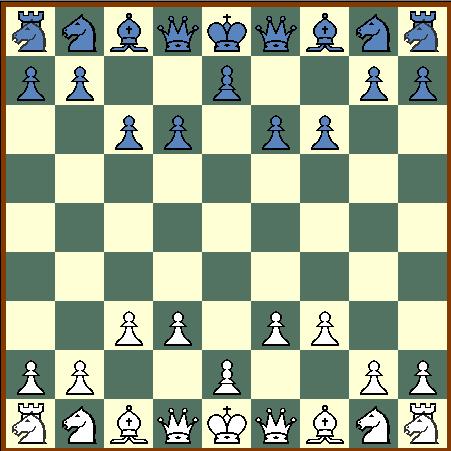Kristensen's Game
Introduction
David Pritchard called Kristensen's Game "a conscious attempt to restructure Chess in order to give the game symmetry and balance." Like most attempts to reinvent Chess, it was unsuccessful, but it has many interesting elements. It dates from 1948.Board and Setup

The board is nine by nine. Setup is:
- White
- Pawns: a2 b2 c3 d3 f3 g3 h2 i2
- Barrier Pawn: e2
- Knights: b1 h1
- Bishops: c1 g1
- Rooks: a1 i1
- Queens: d1 f1
- King: e1
- Black
- Pawns: a8 b8 c7 d7 f7 g7 h8 i8
- Barrier Pawn: e8
- Knights: b9 h9
- Bishops: c9 g9
- Rooks: a9 i9
- Queens: d9 f9
- King: e9
General Rules
The rules of Kristensen's Game are identical to those of FIDE Chess, except where noted otherwise below. Stalemate is a loss, as is giving perpetual check.Movement of Pieces
Kings, Queens and Knights move as they do in FIDE Chess, except there is no castling.Rooks have the ability to move like Knights in addition to their normal moves.
Bishops have the ability to take a non-capturing step forward or back in addition to their normal moves.
The Barrier Pawn moves like a King, but may only capture friendly pieces or the opposing Barrier Pawn. Barrier Pawns may only be captured by the opposing Barrier Pawn or their own King.
Pawns may move a step backwards in addition to their regular move, but only the wing Pawns (abhi) may make a double move for their initial move. There is no en passant capture. Pritchard does not say how Pawns promote, but it is reasonable to assume that they promote to Queen, Rook, Bishop or Knight.
Sources
This information is based on the description in Pritchard's Encyclopedia of Chess Variants.Notes
In the setup, all pieces can move, and all Pawns are protected.The scoring rules are interesting, giving an extra half point to the victor if the opposing player is stalemated or gives perpetual check. More interesting, it is forbidden to resign. Pritchard wonders how this would be enforced, but I assume that it simply means that you may not resign a game without resigning the entire tournament.
Computer Play
There is an implementation of Kristensen's Game for Zillions of Games (See below).
Written by Peter Aronson.
WWW page created: July 27th, 2004.
